Agile HXI Universal Needs
June 21, 2022
Agile HXI & Universal Needs
At GutCheck, we think that a holistic understanding of the people who use your products and services is critical to establishing the deep, empathetic connections between people and brands that will sustain and grow your business. That’s why, in our analyses and recommendations, we focus on a key set of latent psychological and emotional factors that influence the connections between brands and people and ultimately affect usage and purchase behavior.
We refer to this as Agile Human Experience Intelligence with a special focus on the factors identified in Figure 1.
Figure 1. Key Factors in Human Experience Intelligence
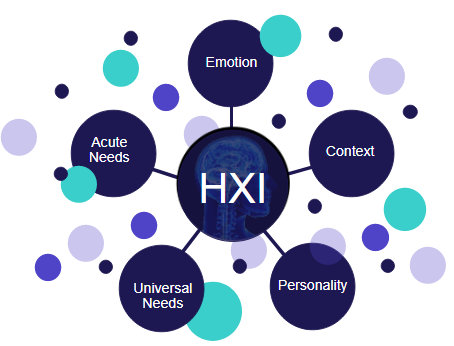
In this and subsequent posts, we will discuss each of these four elements and illustrate how they help us get below the surface level of today’s political, social and economic trends so we can be more empathetic to those who buy and use our products and services.
In this and subsequent posts, we will discuss each of these four elements and illustrate how they help us get below the surface level of today’s political, social and economic trends so we can be more empathetic to those who buy and use our products and services.
Universal Needs
Needs operate at multiple levels (ongoing/continuous versus acute/immediate) and can change based on the context. In this post we will focus on universal human needs that, according to psychologists like Maslow and global insights practitioners like Ford, serve as foundational motivations for human behavior. These universal needs are shown in Figure 2.
Figure 2. Universal Human Needs
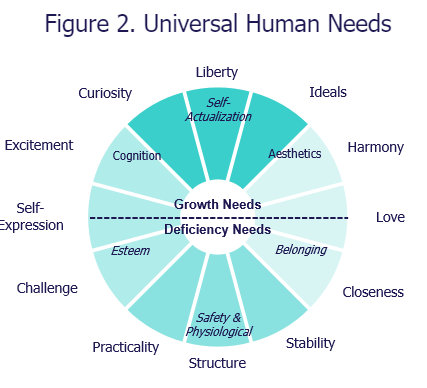
Depending on the context, the most salient or pressing needs that people have can fluctuate from growth to deficiency and back again. And basic physiological and security needs must be satisfied before a person can spend much time addressing other needs.
And where are people now? The broader context includes a multi-year pandemic, stock market volatility, rising gas prices, increased job availability, gun violence, overall inflation, and fewer required COVID-related restrictions. Given all the recent and current upheaval, which needs are most salient to people in the U.S. today?
Our most recent “GutCheckononics” results shows that, on average, people across all generations and household income groups are operating from a place of deficiency. As depicted in Figure 3, their top needs are to be close and connected to loved ones (closeness need) and to have their self-esteem bolstered by achieving progress on their goals (challenge need). In short, people are currently highly motivated to increase intimacy with friends, family or others they care about and to put some tallies in the win column.
Figure 3. Today’s Most Salient Universal Needs
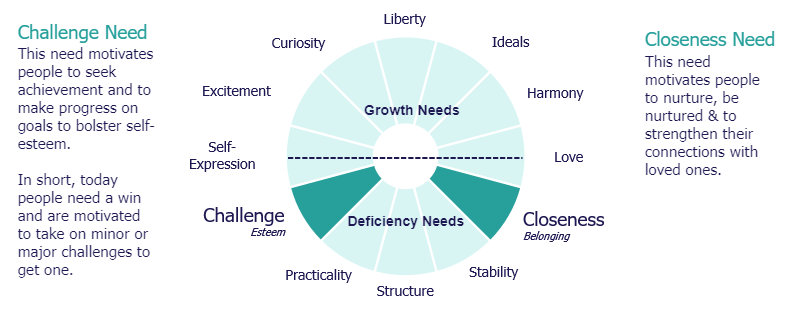
In their own words….
“I’m optimistic for my family reunion in August when my new husband will finally be able to meet my family that wasn’t able to come to our wedding. I’m also excited to visit Disneyland and Southern California with my husband’s family earlier this summer. Spending time with family is a time I cherish.”
“I am looking to finish my brand-new house as I built it from scratch, and I still have a handful of projects to finish and wrap up. I would also like to be available for my parents and help them out as much as possible.”
“I am really concentrating on my garden and working on my various art projects. I would like to have them done before my daughter comes to visit for festival in September.”
“I expect to take my family on a cruise. I expect to make their dreams come true. I hope for happiness.”
Brands & Closeness Needs. Brands that connect people physically or virtually should ensure their customer service agents are well-trained to empathize with those who need their support this summer. Because of travel restrictions or health concerns, people have hungered for improved connections for months or years. Your teams shouldn’t excuse inappropriate behavior, but small kindnesses may go a long way. Other brands can show empathy by acknowledging the importance of close connections through imagery or messaging provided it is authentically conveyed.
Next Up: Context – What impact are major social and political events having on people from different generations or in households with different levels of household income?
Context
But is everyone experiencing today’s uncertainties in the same way? Is the context in which people seek to get these needs met the same for everyone? By context we mean everything from macro-level societal trends to the internal and external factors present as people go about their day-to-day activities, including using and buying products and services.
Of course, the full context that a person faces can be as unique as that person. We begin by acknowledging some of these personal differences. For brands, insights professionals, or anyone working to improve empathy, it’s a useful reminder of the highs and lows people experience underneath the numbers.
My wife and I are trying to start our own business, which includes farming.”
“I think I have met a beautiful woman that will help explore life with me.”
“I have a newborn. I am returning to work after maternity leave in early June and that will take another round of adjustments.”
“Trying to find a better job that doesn’t make me want to claw my eyeballs out.”
For example, the high cost of living/inflation is named as the most important issue by all generations, parents with children at home, and those with household incomes of less than $100,000. Inflation is the second most important issue for those with incomes of $100K+ after the economy in general. In addition, 2/3 of people across all generations and income levels expect prices to continue to rise throughout the summer.
But there are also important differences in how people perceive the current and future context. Table 1 shows which generational or income groups over- or under-index on three key measures of economic perceptions. Cells highlighted in green indicate that a subgroup has a substantially more positive perception of the current and future context while cells highlighted in red indicate a substantially more negative perception.
Gen Z and Millennials are less likely to think now is a bad time to make major household purchases and are less uncertain about whether the future economy will bring good times or bad. Consistent with their perceptions, a twice as many Gen Z and Millennials expect to be better off financially one year from now as compared to more pessimistic Gen X and Baby Boomers. Below, we provide a flavor of these divergent views.
Table 1. Index Scores for Economic Perceptions by Generation and Household Income Level
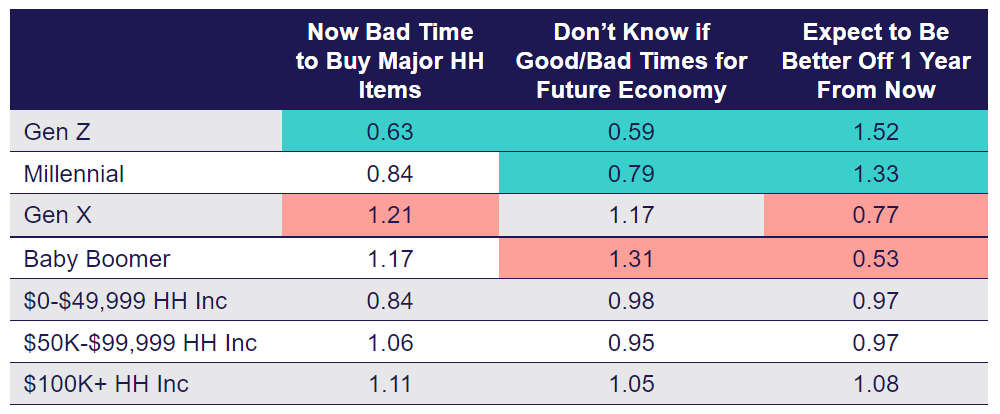
In their own words….
“I am not very positive. I only have part time hours…. Everything costs almost 50% more than it did last year, and I am finding it hard to make ends meet.”
“I feel my finances will get worse by the end of the summer, because stocks are going down and …inflation is getting worse.”
“I’m very hopeful the things will turn around for the better, but I’m not expecting it — kind of like praying for the best but expecting the worst.”
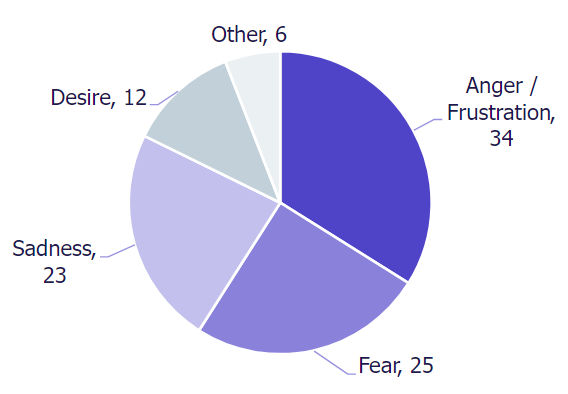
Based on coding of open-ended responses when people are asked to react to the phrase “situation with Russia/Ukraine,” the emotions of anger or frustration, fear and sadness are common across all generations and income levels.
Brands & the U.S. Economic Context. There is no single common perception about the current and future economic context. These results show there was somewhat more optimism among younger generations versus older generations. Whether that optimism will continue remains to be seen. Brands, especially those whose target market spans younger and older generations, will need messaging with a “just right” tone – not too optimistic and not too pessimistic – to avoid creating disconnects with people who buy and use their products.
Brands & the Russian/Ukrainian Context. Although it’s not their first concern, this international conflict does weigh on people’s minds for both humanitarian and economic reasons. And when the topic is made highly salient to them, they experience a range of emotions with negative emotional valence including some like fear and anger that are highly energizing (arousing). Brands may want to review their digital or other ad placement to avoid having these emotions spill over. And empathetic brands may want to go further to partner with organizations like the Red Crescent/Red Cross to help people feel like they can contribute in some positive way.
Next up: Emotions – Surface-level and what lies beneath.
Emotion
As shown in Figure 1, as they think about the summer ahead, many people say they are hopeful, happy, or excited, but a sizable group is anxious or fearful. These results are self-reports from a list of 8 emotions plus other so are more of a surface-level, top of mind measure of the emotions they are experience as they think about what lies ahead for them this summer.
Figure 1. Emotions & Feelings about the Summer (Self-Reported)

Applying hybrid natural language processing and coding the emotions detected in these text-based responses revealed additional depth. Beneath the surface, this previously identified positive outlook is fragile. Although happiness rises to the top, stress and fear loom larger than people are saying directly.
In their own words….

(Total : n=345 with detectable emotion out of 983 valid OEs after cleaning
Next up: Personality traits
